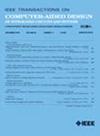基于卷积和变压器层的双多模态融合VLSI拥塞预测
IF 2.7
3区 计算机科学
Q2 COMPUTER SCIENCE, HARDWARE & ARCHITECTURE
IEEE Transactions on Computer-Aided Design of Integrated Circuits and Systems
Pub Date : 2024-12-23
DOI:10.1109/TCAD.2024.3522199
引用次数: 0
摘要
在超大规模集成电路(VLSI)物理设计中,精确的拥塞预测对于提高可达性和加速设计过程至关重要。现有的拥塞预测模型在处理多模态信息时经常遇到困难,并且缺乏位置和网表特征的有效融合,限制了其预测精度。在本文中,我们提出了一种新的拥塞预测模型,该模型利用卷积和变压器层的双多模态融合来有效地捕获多尺度放置信息,提高拥塞预测的准确性。我们首先采用卷积神经网络(cnn)提取基于网格的位置特征,并采用异构图卷积网络(HGCNs)提取网表信息。为了帮助模型理解不同模态之间的相关性,我们提出了一种早期特征融合(EFF),将网表知识集成到多模态交互子空间的多尺度放置特征中。此外,提出了一种基于自适应注意力增强技术的深度特征融合(DFF)方法,进一步融合多模态特征,该方法具有多个视觉变形层。这些层包括用于增强模态内特征的自注意层(SA)和用于对基于网表和网格的放置特征进行跨模态特征融合的交叉注意层(CA)。最后,将DFF的输出特征发送到级联解码器中,通过利用多个上采样层并与EFF特征合并来恢复拥塞图。与现有最先进的拥塞预测模型相比,实验结果表明,我们的模型不仅在预测精度上优于现有模型,而且在集成到placer DREAMPlace后,在减少路由拥塞方面也表现出色。本文章由计算机程序翻译,如有差异,请以英文原文为准。
Dual Multimodal Fusions With Convolution and Transformer Layers for VLSI Congestion Prediction
In very large scale integration (VLSI) circuit physical design, precise congestion prediction during placement is crucial for enhancing routability and accelerating design processes. Existing congestion prediction models often encounter challenges in handling multimodal information and lack effective fusion of placement and netlist features, limiting their prediction accuracy. In this article, we present a novel congestion prediction model that leverages dual multimodal fusions with convolution and transformer layers to effectively capture the multiscale placement information and enhance congestion prediction accuracy. We first adopt convolutional neural networks (CNNs) to extract grid-based placement features and heterogeneous graph convolutional networks (HGCNs) to extract netlist information. To help the model understand the correlation between different modalities, we then propose an early feature fusion (EFF) to integrate netlist knowledge into multiscale placement features at multimodal interaction subspace. Besides, a deep feature fusion (DFF) method is proposed to further fuse multimodal features, which has multiple vision transformer layers based on adaptive attention enhancement technology. These layers include self-attention (SA) to boost intramodal features and cross-attention (CA) to perform cross-modal feature fusion on netlist and grid-based placement features. Finally, the output features of DFF are sent into the cascaded decoder to recover the congestion map by exploiting several upsampling layers and merging with EFF features. Compared with the existing state-of-the-art congestion prediction models, experimental results demonstrate that our model not only outperforms them in prediction accuracy, but also excels in reducing routing congestion when integrated into the placer DREAMPlace.
求助全文
通过发布文献求助,成功后即可免费获取论文全文。
去求助
来源期刊
CiteScore
5.60
自引率
13.80%
发文量
500
审稿时长
7 months
期刊介绍:
The purpose of this Transactions is to publish papers of interest to individuals in the area of computer-aided design of integrated circuits and systems composed of analog, digital, mixed-signal, optical, or microwave components. The aids include methods, models, algorithms, and man-machine interfaces for system-level, physical and logical design including: planning, synthesis, partitioning, modeling, simulation, layout, verification, testing, hardware-software co-design and documentation of integrated circuit and system designs of all complexities. Design tools and techniques for evaluating and designing integrated circuits and systems for metrics such as performance, power, reliability, testability, and security are a focus.

 求助内容:
求助内容: 应助结果提醒方式:
应助结果提醒方式:


